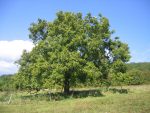 Also called the Persian walnut, this deciduous tree is native to the area from southeastern Europe to China and belongs to the Juglandaceae plant family that also includes pecan and hickory. Although the nuts of the English walnut tree are economically important, the tree itself is a beautiful ornamental with handsome bark, long chartreuse catkins, and an elegant canopy of pinnately compound leaves. The trees grow 30-50′ tall and produce nuts in bright green husks that mature to brown and wither away. Photo Credit Wikipedia
Also called the Persian walnut, this deciduous tree is native to the area from southeastern Europe to China and belongs to the Juglandaceae plant family that also includes pecan and hickory. Although the nuts of the English walnut tree are economically important, the tree itself is a beautiful ornamental with handsome bark, long chartreuse catkins, and an elegant canopy of pinnately compound leaves. The trees grow 30-50′ tall and produce nuts in bright green husks that mature to brown and wither away. Photo Credit Wikipedia
The Hebrew word אגוז means nut and in Song of Songs 6.11 the walnut is probably meant. The Persian walnut tree was native to Iran and Josephus says it flourished in Palestine especially around the Lake of Gennesareth.
Song of Songs 6.11 (NIV) The bride describes her meeting with her bridgroom.
“I went down to the grove of nut trees to look at the new growth in the valley, to see if the vines had budded or the pomegranates were in bloom.”
English Walnut likes full sun and average, medium moist, well-drained soil in USDA Hardiness zones 5-9. It does not tolerate prolonged drought and is suceptible to damage by crown rot, water mold fungi, aphids, and walnut husk fly. Older trees should be purned during winter dormancy to thin out crowded or crossing branches or to remove damaged or dead wood. Propagation is by stratified seed, grafting, budding, hardwood cutting or micro-propagation techniques. English walnut was introduced to the Americas by the English colonists by the 1600s and now is cultivated in the United States with a commercially important presence in California especially in the Central Valley. The roots of the tree produce juglone, a chemical that inhibits the growth of many other plants. The fallen leaves are also toxic to other plants and should not be added to compost piles. Many cultivars have been developed providing a variety of characteristics including thickness of shell, taste of meat, bearing time, and size of tree and nut.
The genus name, Juglans, comes from the Latin jovis meaing of Jupiter and glans meaning acorn. The specific epithet, regia, is the Latin word meaning royal and refers to the very high quality of the nuts.
Fruit Description: Nuts are borne in bright green husks that mature to brown and wither away.
Fruit Availability: Fall
Plant Size: 30-50’ H x 30’ W
Light: Full sun
Soil: Fertile, moist, well-drained. Will not tolerate prolonged drought. Soak tree for a half day two weeks before harvest.
Fertilizer: Fertilize once in the spring as buds form and again in the fall just before harvest with a complete fertilizer high in nitrogen such as 18-4-8. Since the roots of the tree extend l½ the size of the canopy be sure to spread the fertilizer through out the area and water in well.
Hardiness: Zones 5-9
Care: Prune older trees during winter dormancy to thin out crowded or crossing branches or to remove damaged or dead wood. Harvest after the green husks have fallen off the nuts, wash, and dry in trays in the sun.
Pests and Diseases: Susceptible to crown rot, water mold fungi, aphids, and walnut husk fly.